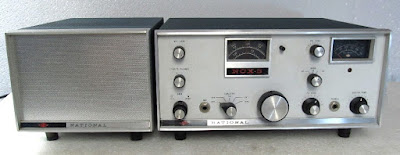I've been troubleshooting the internal counter in my HP8640B signal generator. The generator itself works fine. And the counter works fine for all signals coming in on its "external" port. But the internal counter stopped working properly above 16 MHz. So I started digging into the manuals and the schematics, re-familiarizing myself with the digital logic behind pre-microcontroller frequency counters. NOTE: If you are working on one of these, be sure to be using the correct version of the manual and schematic. At one point I found a really nice high def copy of an HP8640B manual (for one used in a Patriot Missile System!) only to discover that MY A8A3 board was significantly different from the one in this manual. BAMA provided a manual that matched my device: http://bama.edebris.com/manuals/hp/8640b/
Every dark cloud has a silver lining. Here, the silver for me came from opening up the HP8640B. What an impressive looking piece of gear. It looks like something from the Apollo command module, or perhaps from a nuclear weapon. "The RF source is a 256 to 512 MHz cavity-tuned oscillator that is mechanically tuned..." There is phase lock circuitry. The are AM and FM modulators and a really useful array of attenuators. There is a frequency counter with an external port and an internal frequency counter that measures the original 256-512 MHz signal, then divides down to give a very accurate readout of the output frequency. This is the kind of device that would generate a cult following. Count me in!
Also, I've sometimes lamented the lack of VHF test gear on my work bench -- the HP8640B could really help me move me into the VHF range.
I started the troubleshooting with some observations and noodling. At what frequency did the internal counter stop working? What did the readout look like when it stopped working? What device failure could lead to these symptoms? I was aided in this by suggestions sent in by readers of my previous blog posts. Thanks guys.
I was just getting ready to start some intrusive testing on the logic devices in the internal counter when Dave VE3EAC sent me this:
-----------------
I think you might be overthinking the failure mode here. I had a similar problem with my unit and it was one of my early Covid-fix-it projects. There is an assembly that controls the bands on the front. It has the famous gears that crack. On the back side are two sets of rotary switches that control a lot of stuff. The switches are of a very unique HP design and offer a lot of advantages over traditional switches EXCEPT they fail in an unusual manner. A PC board has all of the interesting wiring and very tiny double leaf springs short tracks together as needed. The springs tend to break away from the plastic posts on the rotating plate and not make the needed contact. Very carefully examine the insides of the 8640 and your bench top to see if any have fallen out. These are difficult to buy or fabricate. The disk is designed to be rotated 180 and use a new set of posts to locate the springs. Use a small dab of epoxy to set in place. The totally mechanical repair fixed my unit that also would not read above 16 MHz. There are a number of web pages that give great detail of this repair. Also it is worth while to replace the Delrin gears if they are cracked. Replacement brass ones are available on eBay and they will permanently fix the gear problem.
---------------
I had thought about the problem being in the frequency range switch, but I had sort of tested for this by slowly rocking the switch through various positions as I watched the display. A dirty rotary switch will usually allow the circuit to intermittently work as you rock the switch. But this didn't happen. And the HP switch felt quite sturdy, so I focused on the circuitry.
When I got VE3EAC's message, I carefully flipped the HP8640B over and for the first time opened the bottom of the compartment. The bottom view is much more impressive than the top view:
The switches that VE3EAC wrote about are just below the ribbon cable near the center front. I could see the little springs that he was discussing on the switches. They appear MUCH more delicate than the rotator on a standard rotary switch. And I didn't see any of them lying around below the switch. But when I tried to flip the HP8640B over, something in there moved and caught my eye. I pulled out some tweezers and pulled this out:
Wow. That little spring contact fell off the switch. That was preventing the HP8640B internal counter's time base from changing as I went above 16 MHz. It is ironic that such a big and solidly built device such as the HP8640B should be laid low by such a TINY part.
This gets me back to my original question: Discretion or valor? Getting that spring back onto that switch will not be easy. VE3EAC sent me this K6JCA link describing how to do this. Yikes, it even requires the purchase of a special tool!
I'm going to let the HP8640B sit there with the cover off for a while. It will be taunting me, challenging me to fix it, to make it work the way Hewlett and Packard intended. It may take a while, but I think I'm going to have to accept this challenge. I've become real fan of the HP8640B and it would be a shame to leave it wounded like this.



































